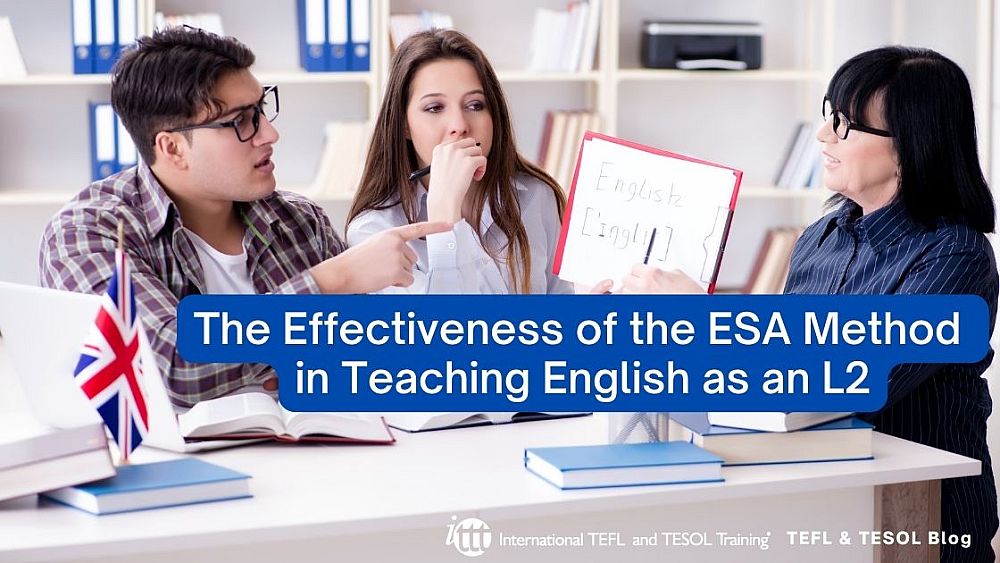The Effectiveness of the ESA Method in Teaching English as an L2

English as a Second Language (ESL) instruction faces the significant challenge of effectively helping non-native speakers grasp the multi-layered intricacies of English. Many approaches to ESL instruction have been developed over the years, each with its own unique strengths and issues. Among these approaches, the Engage-Study-Activate (ESA) method stands out for its adaptability, student-centeredness, and focus on real-life language use.
Table of Contents
Are you ready to teach English as a foreign language?
Check out what our course grads say in our many video testimonials!
Disclaimer: The views and opinions expressed in this blog post are solely those of the author, an alumni of ITTT (International TEFL and TESOL Training). They do not necessarily reflect the views or opinions of ITTT. The content provided in this post is for informational purposes only and should not be considered as official endorsement or representation by ITTT.
The ESA Method
The ESA method, developed by Jeremy Harmer, is a framework for conducting ESL lessons. It consists of three core stages: Engage, Study, and Activate. The Engage stage aims to generate interest and involve students emotionally, ensuring that the learners are ready to engage with the language. This phase is especially focused on creating a fun and stimulating classroom environment. The Study phase is where explicit language instruction takes place, emphasizing grammar, vocabulary, pronunciation, and other language elements. The Activate stage, meanwhile, encourages students to use the language communicatively and creatively in a setting as close to a real-life situation as possible. Role-plays, communication games, or possibly even classroom debates can be utilized effectively to allow students to focus on broad fluency rather than accuracy. These stages form the basis of the ESA method and are key to its effectiveness.
Flexibility and Adaptability
One of the great strengths of the ESA method is its flexibility. Unlike more rigid methodologies, the ESA method allows for adaptability in instruction based on the learner's needs and the type of language material being taught. The core sequence of "Engage-Study-Activate" is more than adequate for most lessons; however, teachers can adjust the sequence of stages according to the class's needs and the desired learning outcomes of a particular lesson. For example, a teacher might opt for an "Activate-Study-Activate" sequence for a more advanced class, allowing students to use language contextually before studying its form. This flexibility in the method ensures a dynamic, adaptable teaching and learning process, leading to more effective learning outcomes.
Elicitation
Elicitation is an extremely important technique that teachers use to draw language from students. This can take the form of asking questions, providing prompts, flashcards, or using gestures and mime. Elicitation helps students to build agency - students become more active participants in the learning process and develop their understanding of the language.
Student-Centered
The ESA method relies on a student-centered approach to language learning. This approach promotes the idea that students learn best when they actively engage in the learning process. The Engage stage draws students into the lesson, the Study phase provides the necessary language tools, and the Activate phase enables them to use these tools communicatively. This process allows learners to take ownership of their learning, building "student discovery" and increasing their motivation and investment in the learning process. Additionally, the ESA method is interaction-driven.
Interaction-Driven Learning
The ESA method, especially during the Activate stage, encourages interaction among students, providing them with the opportunity to negotiate meaning, receive feedback, and learn from each other. This interaction creates a deeper understanding of the language and its practical usage.
Real-Life Language Use
Lastly, the ESA method's effectiveness lies in its emphasis on real-life language use. The method not only provides core language and grammar knowledge but also equips learners with the skills to use the language in real-life situations. The Activate stage, in particular, encourages learners to apply the language in a communicative context. This authentic use of language reinforces learning and enhances the student's ability to communicate effectively in English.
The ESA method has proven effective in teaching English as an L2 due to its flexible and adaptable structure, its student-centered and interaction-driven approach, and its focus on real-life language use. ESA allows for instruction to be tailored to learners' needs and can be adapted to whatever course/language materials might be available. By placing a strong emphasis on interaction and real-life language use, the ESA method helps learners not only understand the language but also use it confidently and effectively. While no single method can be completely effective in all classrooms or with all students, the ESA method provides a versatile, practical, and engaging approach to ESL instruction.
Are you ready to teach English as a foreign language?
Apply now & get certified to teach english abroad!
Speak with an ITTT advisor today to put together your personal plan for teaching English abroad!
Send us an email or call us toll-free at 1-800-490-0531 to speak with an ITTT advisor today.
Related Articles:
- Top 10 Cities in Europe with the Highest Demand for English Language Teachers
- 5 Reasons To Take A TEFL Course Right Now - Even If You Are Not Leaving Yet | ITTT | TEFL Blog
- All the Documents You Will Need to Teach English Abroad
- The Impact of Positive Motivation on an ESL Classroom
- You're Never Too Old to Change Your Life and Do a TEFL Course | ITTT | TEFL Blog
- Getting Student Placement Right - The Best Desk Arrangements for EFL Students



